Traffic jam regulates the function of the ovarian germline stem cell progeny differentiation niche during pre-adult stage in Drosophila
- PMID: 31300663
- PMCID: PMC6626045
- DOI: 10.1038/s41598-019-45317-6
Traffic jam regulates the function of the ovarian germline stem cell progeny differentiation niche during pre-adult stage in Drosophila
Abstract
Stem cell self-renewal and the daughter cell differentiation are tightly regulated by the respective niches, which produce extrinsic cues to support the proper development. In Drosophila ovary, Dpp is secreted from germline stem cell (GSC) niche and activates the BMP signaling in GSCs for their self-renewal. Escort cells (ECs) in differentiation niche restrict Dpp outside the GSC niche and extend protrusions to help with proper differentiation of the GSC daughter cells. Here we provide evidence that loss of large Maf transcriptional factor Traffic jam (Tj) blocks GSC progeny differentiation. Spatio-temporal specific knockdown experiments indicate that Tj is required in pre-adult EC lineage for germline differentiation control. Further molecular and genetic analyses suggest that the defective germline differentiation caused by tj-depletion is partly attributed to the elevated dpp in the differentiation niche. Moreover, our study reveals that tj-depletion induces ectopic En expression outside the GSC niche, which contributes to the upregulated dpp expression in ECs as well as GSC progeny differentiation defect. Alternatively, loss of EC protrusions and decreased EC number elicited by tj-depletion may also partially contribute to the germline differentiation defect. Collectively, our findings suggest that Tj in ECs regulates germline differentiation by controlling the differentiation niche characteristics.
Conflict of interest statement
The authors declare no competing interests.
Figures

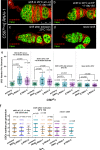
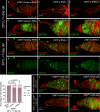


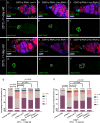
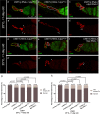
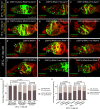

Similar articles
-
The Osa-Containing SWI/SNF Chromatin-Remodeling Complex Is Required in the Germline Differentiation Niche for Germline Stem Cell Progeny Differentiation.Genes (Basel). 2021 Mar 4;12(3):363. doi: 10.3390/genes12030363. Genes (Basel). 2021. PMID: 33806269 Free PMC article.
-
The Bric-à-Brac BTB/POZ transcription factors are necessary in niche cells for germline stem cells establishment and homeostasis through control of BMP/DPP signaling in the Drosophila melanogaster ovary.PLoS Genet. 2020 Nov 5;16(11):e1009128. doi: 10.1371/journal.pgen.1009128. eCollection 2020 Nov. PLoS Genet. 2020. PMID: 33151937 Free PMC article.
-
Specification and spatial arrangement of cells in the germline stem cell niche of the Drosophila ovary depend on the Maf transcription factor Traffic jam.PLoS Genet. 2017 May 19;13(5):e1006790. doi: 10.1371/journal.pgen.1006790. eCollection 2017 May. PLoS Genet. 2017. PMID: 28542174 Free PMC article.
-
Signal transduction pathways regulating Drosophila ovarian germline stem cells.Curr Opin Insect Sci. 2020 Feb;37:1-7. doi: 10.1016/j.cois.2019.10.002. Epub 2019 Oct 17. Curr Opin Insect Sci. 2020. PMID: 31726320 Review.
-
Molecular control of the female germline stem cell niche size in Drosophila.Cell Mol Life Sci. 2019 Nov;76(21):4309-4317. doi: 10.1007/s00018-019-03223-0. Epub 2019 Jul 12. Cell Mol Life Sci. 2019. PMID: 31300869 Free PMC article. Review.
Cited by
-
Distinct gene expression dynamics in germ line and somatic tissue during ovariole morphogenesis in Drosophila melanogaster.G3 (Bethesda). 2022 Feb 4;12(2):jkab305. doi: 10.1093/g3journal/jkab305. G3 (Bethesda). 2022. PMID: 34849771 Free PMC article.
-
Autophagy is required for spermatogonial differentiation in the Drosophila testis.Biol Futur. 2022 Jun;73(2):187-204. doi: 10.1007/s42977-022-00122-7. Epub 2022 Jun 7. Biol Futur. 2022. PMID: 35672498 Review.
-
Diverse somatic Transformer and sex chromosome karyotype pathways regulate gene expression in Drosophila gonad development.bioRxiv [Preprint]. 2024 Aug 12:2024.08.12.607556. doi: 10.1101/2024.08.12.607556. bioRxiv. 2024. PMID: 39372789 Free PMC article. Preprint.
-
Cyromazine affects the ovarian germ cells of Drosophila via the ecdysone signaling pathway.Front Physiol. 2022 Sep 29;13:992306. doi: 10.3389/fphys.2022.992306. eCollection 2022. Front Physiol. 2022. PMID: 36246127 Free PMC article.
-
Tissue-specific regulation of translational readthrough tunes functions of the traffic jam transcription factor.Nucleic Acids Res. 2022 Jun 24;50(11):6001-6019. doi: 10.1093/nar/gkab1189. Nucleic Acids Res. 2022. PMID: 34897510 Free PMC article.
References
Publication types
MeSH terms
Substances
LinkOut - more resources
Full Text Sources
Molecular Biology Databases
Research Materials

